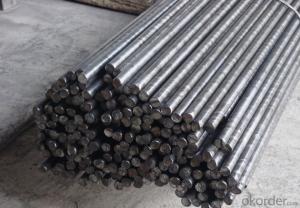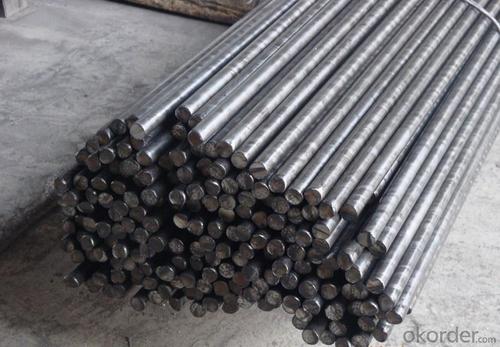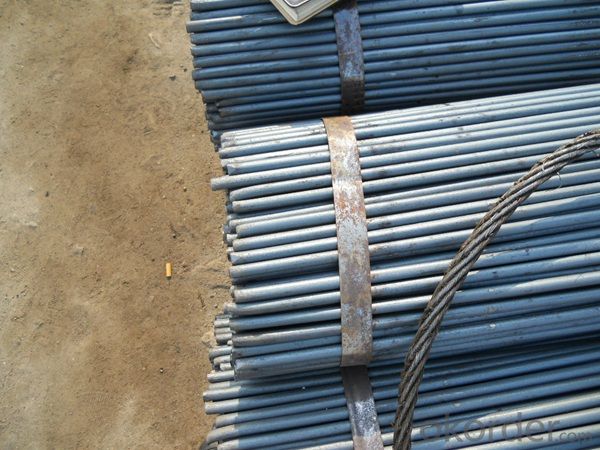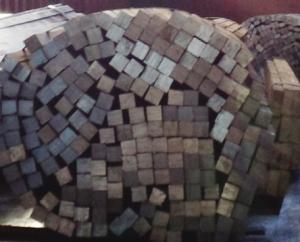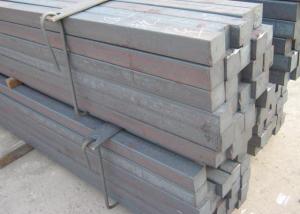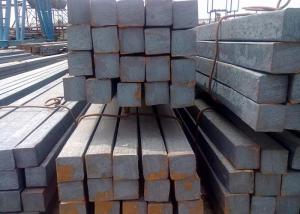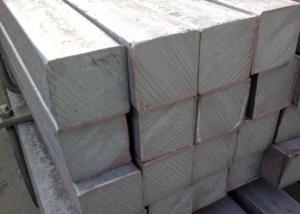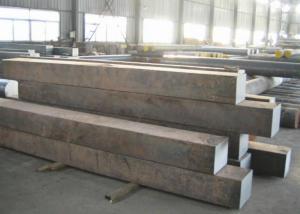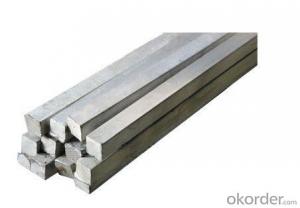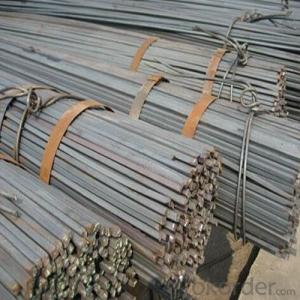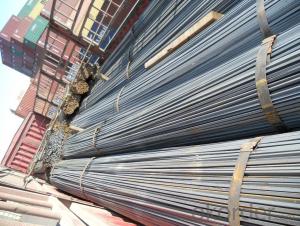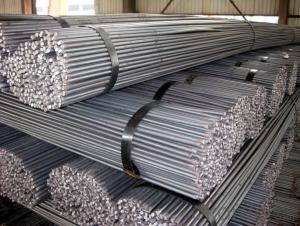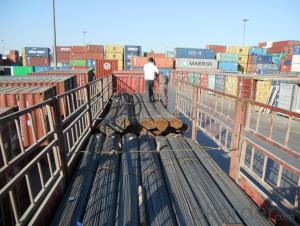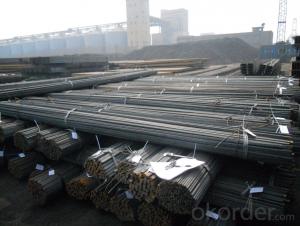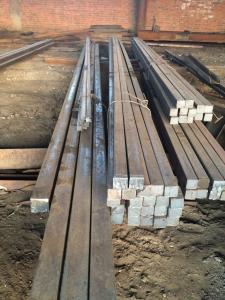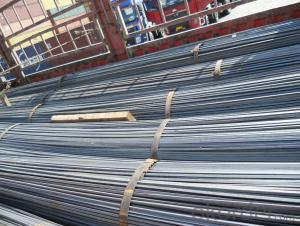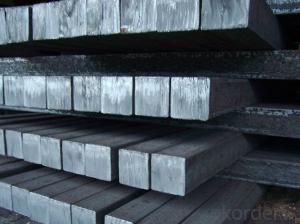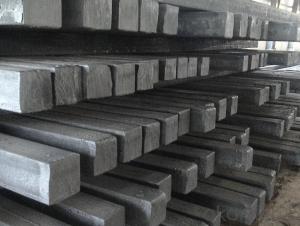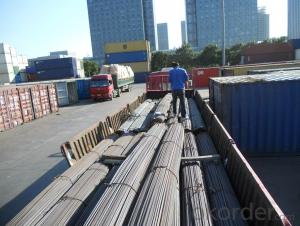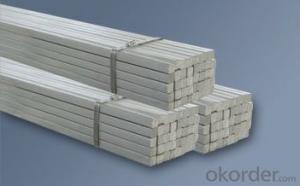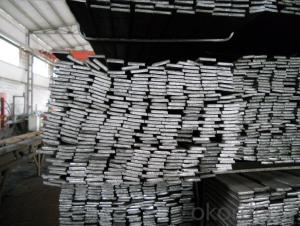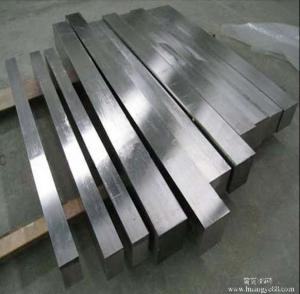Hot Rolled Round Steel Bars with Cr A36, Q235, SS400
- Loading Port:
- Tianjin
- Payment Terms:
- TT OR LC
- Min Order Qty:
- 25 m.t.
- Supply Capability:
- 200000 m.t./month
OKorder Service Pledge
OKorder Financial Service
You Might Also Like
Specification
Product Description:
Hot Rolled Round Steel Bars with Cr A36, Q235, SS400 is used for manufacturing ball, roller bearing steel and rings. Bearing in work is under great pressure and friction, so have high demands bearing steel and hardness and resistance, and high elastic limit.
Bearing steels are used for ball and roller bearing applications and are comprised of low carbon steels and high carbon through harden able steel.
For example, bearing ring, steel rolling mill, machinery, 100Cr6 bearing steel ball is widely used in high-speed and low-noise bearing, bicycle, motorcycle, automobile, bags electronically.
Product Applications:
Hot Rolled Round Steel Bars with Cr A36, Q235, SS400 are ideal for structural applications and are widely used in the construction of buildings and bridges, and the manufacturing, petrochemical, and transportation industries.
1. Steel round bar products is used in construction and a large number of architectural and engineering structures. And it can be used in production of handrail, windows, machinery, telecom and curtain wall.
2. It can be used in the fields like metal mines, cement plants, water coal slurry, power stations and chemical industry.
3. Besides, we can supply some especial material steel round bar that can be used for main shaft of steamer, hummer shank, with big section and supper force.
4. Recommended watchcase factory, screw factory and other cold stamping products industry use.
Product Advantages:
OKorder's Hot Rolled Round Steel Bars with Cr A36, Q235, SS400 are durable, strong, and resist corrosion.
1. The steel in which the main interstitial alloying constituent is carbon in the range of 0.12–2.0%.
2. As the carbon percentage content rises, steel has the ability to become harder and stronger through heat treating; however it becomes less ductile.
3. Regardless of the heat treatment, higher carbon content reduces weld ability. In carbon steels, the higher carbon content lowers the melting point.
4. Quality should be in conformity with the specification of the manufacturer. Quantity and packing conditions should be in conformity with the term in the contract.
Main Product Features:
· Premium quality
· Prompt delivery & seaworthy packing (30 days after receiving deposit)
· Corrosion resistance
· Can be recycled and reused
· Mill test certification
· Professional Service
· Competitive pricing
Specifications of Hot Rolled Round Steel Bars with Cr A36, Q235, SS400
1. Grade: Q235, A36, SS400, S235JR
2. Feature: Unbreakable, grinding resistant and high impact value
3. Diameter: 8mm-150mm
4. Performance: Mainly for civil construction
5. Characteristics: Even hardness, no deformation, no breaking, no mal-roundness
6. Technique: Hot rolled
7. Mass: Mass (kg/m) = Diameter (mm) × Diameter (mm) × 0.00617
Packaging & Delivery of Hot Rolled Round Steel Bars with Cr A36, Q235, SS400
Packaging Detail: All goods are packed in bundle with steel strips and shipped by break bulk vessel or container (depend on target market and different ports)
Delivery Detail: 45 days
Trade terms: FOB, CFR, CIF
MOQ: 25 tons per specification; we can negotiate the quantity if the specification is normal or we have stock of one specification.
Weight: The price invoicing on theoretical weight basis or actual weight basis depends on customer’s request.
Shipment: The shipment of bulk break or container is depends on customer’s request and the situation of the port of destination.
Documents given: Full set of original clean on board bill of lading; Original signed commercial invoice; Original packing list; Policy of insurance; Certificate of origin and what the target market needs.
Production Flow of Hot Rolled Round Steel Bars with Cr A36, Q235, SS400
Material prepare (billet) — heat up — rough rolling — precision rolling — cooling — packing — storage and transportation
FAQ:
Q1: The products are invoicing on theoritical weight or on actual weight?
A1: We can do it in both manners, according to the customers' request.
Q2: What is the normal tolerance of Hot Rolled Round Steel Bars with Cr A36, Q235, SS400?
A2: Normally 3%-5%, but we can also produce the goods according to the customers' requests.
Q3: How soon can we receive the product after purchase?
A3: Within three days of placing an order, we will begin production. The specific shipping date is dependent upon international and government factors, but is typically 7 to 10 workdays.
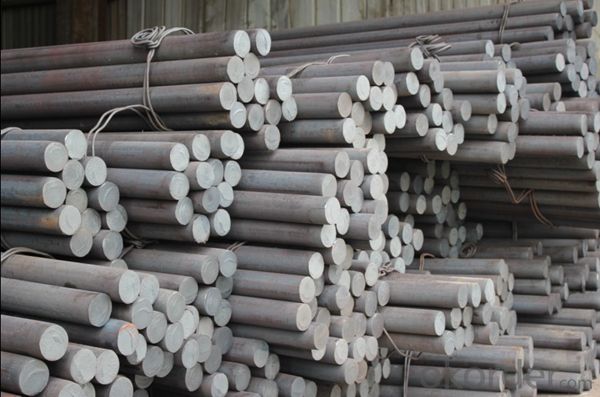
- Q: How do you use a steel square to determine the slope of a garden bed?
- To use a steel square to determine the slope of a garden bed, you can follow these steps: 1. Start by placing one edge of the steel square against the ground at the lowest point of the garden bed. 2. Ensure that the steel square is level by using a bubble level or by checking that the bubble is centered within the level. 3. Once the steel square is level, hold it steady in that position. 4. Look at the other edge of the square that is extending away from the ground. This edge represents the slope of the garden bed. 5. Observe the markings on the steel square. Most steel squares have measurements and angles marked on them. 6. Read the measurement or angle that corresponds to the line created by the edge of the square. This will give you the slope of the garden bed. 7. You can either note down the measurement or angle for future reference or use it to make necessary adjustments to the garden bed. By using a steel square, you can accurately determine the slope of a garden bed, which is crucial for proper drainage and irrigation.
- Q: How do you use a steel square to determine the size of a circle?
- Determining the size of a circle using a steel square directly is not possible, as a steel square is primarily designed for measuring angles and distances between points. However, it is possible to indirectly determine the size of a circle by utilizing a steel square in combination with other tools or methods. One possible approach involves utilizing the steel square to measure either the diameter or radius of the circle. The diameter refers to the distance across the circle passing through its center, while the radius represents the distance from the center to any point on the edge of the circle. To measure the diameter, position the steel square against the circle in a manner that it touches two points on the edge. Utilize the scale on the steel square to measure the distance between these two points. This measurement will provide the diameter of the circle. To measure the radius, position the steel square against the circle in a manner that it touches the edge at a single point. Measure the distance from this point to the center of the circle using the scale on the steel square. This measurement will provide the radius of the circle. Once the diameter or radius of the circle is obtained, mathematical formulas or trigonometry can be employed to determine its size, including calculations for the circumference or area of the circle.
- Q: How do you use a steel square to lay out a half-lap joint?
- To use a steel square to lay out a half-lap joint, you will need the following materials: a steel square, a pencil or marking knife, and the pieces of wood you wish to join together. First, determine the desired size of the half-lap joint by measuring the thickness of the wood and deciding how much overlap you want between the two pieces. This overlap typically ranges from one-third to one-half of the thickness of the wood. Next, place the steel square on one of the pieces of wood at the location where you want the joint to be. Ensure that the square's blade and tongue are aligned with the edges of the wood. The blade should be against one face of the wood while the tongue extends along the adjacent face. Using a pencil or marking knife, mark a line along the blade of the square onto the wood. This line represents the depth of the half-lap joint. After marking the first piece of wood, repeat the process on the second piece, ensuring that the marks align with those on the first piece. This will ensure a proper fit when the joint is assembled. Now, you can use the square to mark the width of the joint. Place the square on the edge of the wood, aligning the tongue with the previously marked depth line. With the square in position, mark a line across the face of the wood using the blade as a guide. Repeat this process on both pieces of wood to ensure accurate alignment. Finally, use a saw to cut along the marked lines, removing the waste material to create the half-lap joint. Take care to stay within the marked lines, as this will determine the final fit of the joint. Once the joint is cut, test the fit by joining the two pieces together. Make any necessary adjustments to ensure a snug fit, and then use glue or other appropriate fasteners to secure the joint. By following these steps and using a steel square as a guide, you can accurately lay out and create a strong and secure half-lap joint.
- Q: Can a steel square be used for checking the squareness of a door frame opening?
- A door frame opening can be checked for squareness using a steel square. The steel square, also called a framing square or carpenter's square, is a versatile tool commonly used in carpentry and construction. It has a shape of a right angle, with one arm longer than the other, making it suitable for measuring angles and checking the squareness of objects. To check the squareness of a door frame opening, position the steel square against the inside corner of the frame. Ensure that the long arm aligns with one side of the frame, while the shorter arm aligns with the other side. If the frame is perfectly square, the edges of the square will fit perfectly against both sides of the frame. However, if the frame is not square, there will be a gap between the square and one or both sides of the frame, indicating the need for adjustments. Using a steel square is a reliable and precise way to check the squareness of a door frame opening. It enables the identification of any discrepancies and allows for necessary adjustments to be made, ensuring proper fit and functionality of the door.
- Q: Can a steel square be used for checking the flatness of a countertop joint?
- Using a steel square to assess the flatness of a countertop joint is not suitable. The steel square serves as a measuring tool for right angles, mainly employed for marking and confirming squareness. Its purpose does not involve precise measurement of a surface's flatness or levelness. For a more suitable evaluation of a countertop joint's flatness, one should consider employing either a straightedge or a precision level.
- Q: Can a steel square be used for measuring angles in metal roofing?
- Yes, a steel square can be used for measuring angles in metal roofing. A steel square, also known as a framing square or carpenter's square, is a versatile tool that is commonly used in construction and carpentry. It has a right angle shape and is typically made of steel, hence the name. To measure angles in metal roofing, the steel square can be used in various ways. One method involves placing the square against the edge of the metal roof sheet and aligning it to the desired angle. The other side of the square can then be used as a guide to mark the correct angle on the metal sheet. Another method involves using the square as a protractor by placing the longer side of the square along the edge of the metal sheet and rotating it until the desired angle is achieved. The angle can then be measured using the markings on the square. It is important to note that while a steel square can be used for measuring angles in metal roofing, it may not be the most precise tool for this purpose. For more accurate measurements, specialized tools such as a protractor or angle finder may be more suitable. Additionally, it is always recommended to consult professional guidelines and instructions specific to metal roofing installations to ensure accurate measurements and proper installation techniques.
- Q: How do you use a steel square to check for levelness on a shelf?
- To use a steel square to check for levelness on a shelf, place the steel square against the edge of the shelf and ensure it is flush with the surface. Then, use a spirit level to check if the bubble is centered within the level. If it is, the shelf is level. If not, adjustments can be made based on the reading to achieve a level surface.
- Q: How do you use a steel square for marking roof hip angles?
- To use a steel square for marking roof hip angles, you will need to follow a few steps. First, make sure that your steel square is clean and in good condition. To begin, position the square on the edge of the roof hip with one leg of the square aligned with the roof slope. The other leg of the square should be aligned with the ridge of the roof. Next, adjust the square until it is perfectly level and perpendicular to the roof surface. This will ensure accurate measurements and markings. Once the square is properly aligned, you can use a pencil or marker to mark the desired angle on the roof surface. Make sure to mark both sides of the hip for accurate cutting and installation. After marking the angles, you can use a saw or other cutting tool to cut along the marked lines. It is important to note that using a steel square requires precision and accuracy, so take your time and double-check your measurements before making any cuts. Additionally, always prioritize safety by wearing appropriate protective gear and using caution when working at heights.
- Q: How do you use a steel square to determine angles for stair nosing?
- To use a steel square to determine angles for stair nosing, you will need to follow these steps: 1. Place the steel square on the edge of the stair tread, aligning one of its legs with the vertical riser and the other leg with the horizontal tread. 2. Make sure the square is securely positioned against the edge of the tread and riser to obtain accurate measurements. 3. Once the square is properly aligned, use a pencil or marker to mark the angle on the tread. 4. Next, transfer the marked angle onto the stair nosing material. Place the square against the nosing material, aligning the leg with the edge that will be installed on the stair tread. 5. Use a pencil or marker to mark the angle on the material, ensuring that the line is clear and visible. 6. Finally, cut along the marked line using a saw or appropriate cutting tool to obtain the correct angle for the stair nosing. By using a steel square in this manner, you can accurately determine and transfer angles onto stair nosing material, ensuring a precise fit and a professional-looking finish for your stairs.
- Q: What are the different ways to read angles on a steel square when working with metal?
- When working with metal, there are multiple ways to read angles on a steel square. Here are a few common methods: 1. Degree Scale: Many steel squares have a degree scale engraved on the blade. This scale allows you to directly read the angle in degrees by aligning the desired angle with the reference line on the blade. 2. Protractor: Using a protractor in conjunction with a steel square can provide more precise angle measurements. Place the protractor against the blade of the square and align the reference line with the desired angle. Read the angle measurement directly from the protractor. 3. Vernier Scale: Some advanced steel squares may have a vernier scale. This scale provides even more precise angle readings. Align the desired angle with the reference line and read the corresponding value on the vernier scale. The vernier scale allows for more accurate measurements by providing additional subdivisions. 4. Digital Angle Finder: For those who prefer digital tools, a digital angle finder can be used in conjunction with a steel square. Place the square against the workpiece and then use the digital angle finder to measure the angle. This tool provides precise measurements and can be especially helpful when working with complex angles. 5. Combination Square: A combination square is a versatile tool that includes a ruler, a level, and an adjustable blade. By adjusting the blade to the desired angle, you can easily read the angle measurement on the scale provided on the blade. Remember, regardless of the method used, it is crucial to ensure that the steel square is securely placed against the workpiece to obtain accurate angle readings.
Send your message to us
Hot Rolled Round Steel Bars with Cr A36, Q235, SS400
- Loading Port:
- Tianjin
- Payment Terms:
- TT OR LC
- Min Order Qty:
- 25 m.t.
- Supply Capability:
- 200000 m.t./month
OKorder Service Pledge
OKorder Financial Service
Similar products
Hot products
Hot Searches
Related keywords
